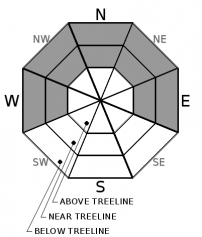| Saturday | Saturday Night | Sunday | |
|---|---|---|---|
| Weather: | Sunny. Snow levels below 7000 feet. Chance of precipitation is 0%. | Clear. Snow levels below 7000 feet. Chance of precipitation is 0%. | Sunny. Snow levels below 7000 feet increasing to 7000 feet in the afternoon. Chance of precipitation is 0%. |
| Temperatures: | 40 to 45 deg. F. | 25 to 31 deg. F. | 43 to 48 deg. F. |
| Mid Slope Winds: | Light winds. | Light winds. | Light winds. |
| Expected snowfall: | No accumulation. | SWE = none. | No accumulation. | SWE = none. | No accumulation. | SWE = none. |
| Saturday | Saturday Night | Sunday | |
|---|---|---|---|
| Weather: | Sunny. Snow levels below 7000 feet. Chance of precipitation is 0%. | Clear. Snow levels below 7000 feet. Chance of precipitation is 0%. | Sunny. Snow levels below 7000 feet increasing to 7000 feet in the afternoon. Chance of precipitation is 0%. |
| Temperatures: | 37 to 42 deg. F. | 24 to 30 deg. F. | 39 to 45 deg. F. |
| Ridge Top Winds: | West 15 to 25 mph with gusts to 45 mph. | West 15 to 20 mph with gusts to 40 mph. | West around 15 mph with gusts to 25 mph in the morning becoming light. |
| Expected snowfall: | No accumulation. | SWE = none. | No accumulation. | SWE = none. | No accumulation. | SWE = none. |


















